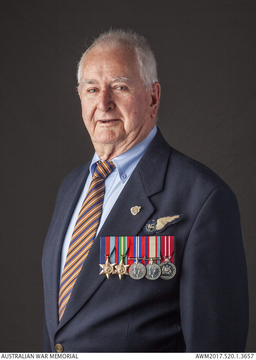CAMPBELL, Stewart John
| Service Number: | 441381 |
|---|---|
| Enlisted: | 31 July 1943 |
| Last Rank: | Warrant Officer |
| Last Unit: | Not yet discovered |
| Born: | Wyalkatchem, Western Australia, Australia, 3 June 1925 |
| Home Town: | Not yet discovered |
| Schooling: | Not yet discovered |
| Occupation: | Not yet discovered |
| Memorials: |
World War 2 Service
| 31 Jul 1943: | Enlisted Royal Australian Air Force, Warrant Officer, 441381 | |
|---|---|---|
| 7 Dec 1945: | Discharged Royal Australian Air Force, Warrant Officer, 441381 |
Help us honour Stewart John Campbell's service by contributing information, stories, and images so that they can be preserved for future generations.
Add my storyBiography contributed by David Flint
From Matt Keogh Facebook - 3/6/25 celebrating Stewarts 100th Birthday
Stewart was born in Wyalcatchem in Western Australia and is a veteran of the Second World War.
Before his war service, Stewart worked on the family farm. He joined the Air Training Corps (Air Force Cadets) in 1942 and then enlisted in the Royal Australian Air Force (RAAF) in July 1943, aged just 18. Stewart completed his initial training at Clontarf, Perth, before training as an air gunner at Ballarat, Victoria, and Port Pirie, South Australia. In 1944, he completed advanced gunnery training on B-24 Liberator heavy bombers in Australia and New Guinea.
In January 1945, Stewart was posted to No. 23 Squadron, deploying to Long Airfield in the Northern Territory three months later. From there, he flew on bombing missions and anti-shipping strikes in the Netherlands East Indies (now Indonesia), Morotai and then in Balikpapan in Borneo.
Stewart recalls being involved in very dangerous air combat with the Japanese over Buru Island in Indonesia. The Japanese fire was very intense, but the crew of his plane put up a gallant fight and thankfully, the Liberator returned with no casualties.
In December 1945, Stewart was discharged from the RAAF. He says he enjoyed the camaraderie while serving and the reunions afterwards. Stewart advises younger serving personnel that the RAAF is ‘a good career and your mates will have your back’.
After the war, Stewart worked for the railways and became a station master. He married Dorothy in 1960, and they have 6 children, 13 grandchildren and 21 great grandchildren.

















